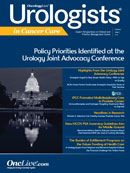New NCCN Prostate Cancer Screening Guidelines Aim for Middle Ground
New prostate cancer screening guidelines that seek to balance overtreatment concerns with the need to preserve gains in curbing prostate cancer mortality were unveiled at the National Comprehensive Cancer Network's 19th Annual Conference.
Peter R. Carroll, MD, MPH
New prostate cancer screening guidelines that seek to balance overtreatment concerns with the need to preserve gains in curbing prostate cancer mortality were unveiled at the National Comprehensive Cancer Network’s 19th Annual Conference, Advancing the Standard of Cancer Care, held March 14 in Hollywood, Florida.
Peter R. Carroll, MD, MPH, said the new guidelines, which call for starting screening as early as age 45 years and continuing it past age 70 years for patients in good health and without other comorbidities, would reduce overdetection by as much as 45%.
For 2 years, prostate cancer screening has been among the most contentious issues in cancer prevention. Since the development of the prostate-specific antigen (PSA) test, specialists promoted the screening tool among men and succeeded in trimming the prostate cancer mortality rate 45% in the United States-—a drop so steep it accounted for 20% of the overall drop in cancer mortality in men since 1930. An unqualified success, right?
Not according to the US Preventive Services Task Force (USPSTF), which in May 2012 stunned urologists and the cancer prevention community when it gave the PSA test a rating of D, saying that the benefits did not outweigh the harms. All that screening had led to overtreatment, USPSTF said. The entity’s recommendations are significant; only ratings of B or higher ensure reimbursement from Medicare and Medicaid, and private insurers often follow suit.
“We achieved a 45% reduction in mortality in prostate cancer in the United States, in contrast with an increase worldwide,” Dr Carroll said. “Yet, the USPSTF gives it a D.” “How did we arrive here?”
Both Carroll and his co-presenter, statistician Andrew J. Vickers, PhD, of Memorial Sloan Kettering Cancer Center said the USPSTF had some fundamental misunderstandings about the studies it relied upon in making its decision; Vickers in particular said the two studies, from the United States and Europe, were very different and numbers from each should not have been consolidated. But Carroll did agree with USPSTF on one point: Too much screening can lead to overtreatment.
The American Cancer Society did not agree with USPSTF; the American Urological Association responded with its own guidelines that targeted screening for men aged 55-69 years, although it was vague on when biopsies should occur.
That left the NCCN in a tough spot: The group dedicated to setting standards of care had weighed in on the matter just prior to the USPSTF edict in 2012 with a call for guidelines that Carroll described yesterday as “screen early, screen often, biopsy many.”
Carroll, who is professor and chair of the University of California, San Francisco Department of Urology, said the new guidelines will address the concerns of overtreatment as well as those of professional groups that want to preserve the use of PSA screenings. He said that the changes were being revised right up to the last minute; unlike other new material presented at the conference, these newsworthy guidelines were not included along with other electronic material provided to meeting attendees.
Carroll summarized the new criteria as follows:
- They define a target population based on more recent randomized, controlled trials.
- They seek testing that starts at age 45 to 50 years, with a single PSA test; later testing will be in selective patients based on risk factors.
- Testing will be less frequent.
- Indications for biopsy are more explicit and they will occur with caution: This is the biggest change in the guidelines. Only “highly suspicious” digital exams will be indicated for biopsy.
PSA velocity, by itself, will not be a reason for biopsy. Data will be published soon in support of these new criteria, Carroll said. He and Vickers agreed that the controversy over PSA testing will ebb as molecular profiling helps to resolve ambiguities around those moderate risk patients, for whom it has been a tougher call whether treatment or “watchful waiting” makes sense.




